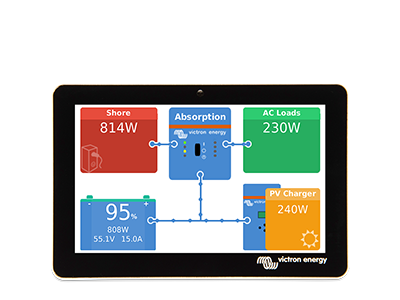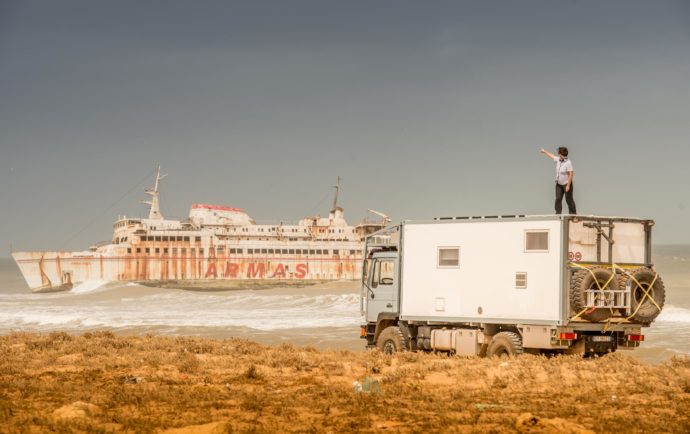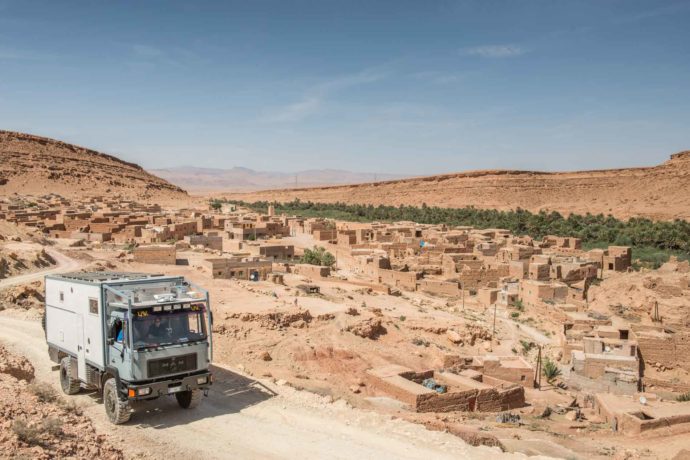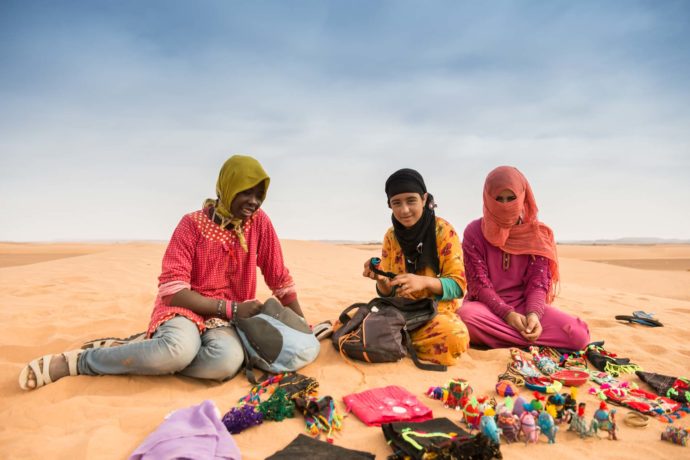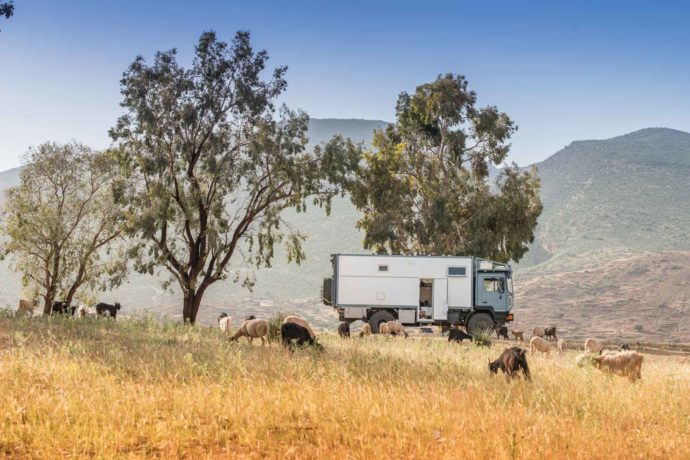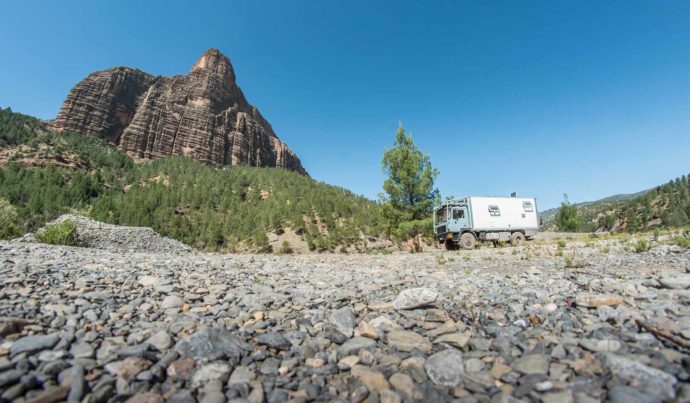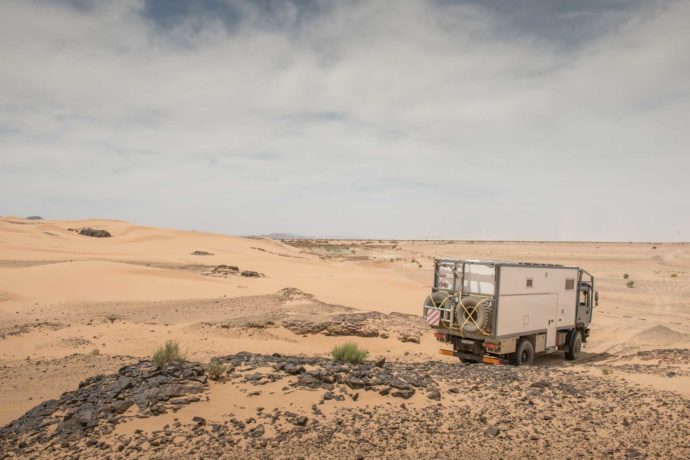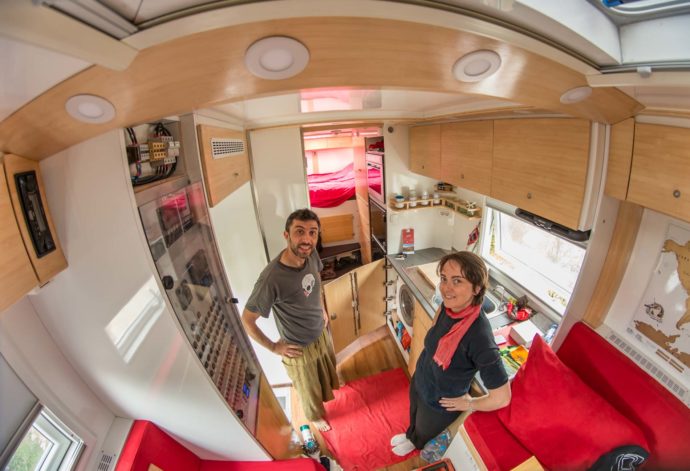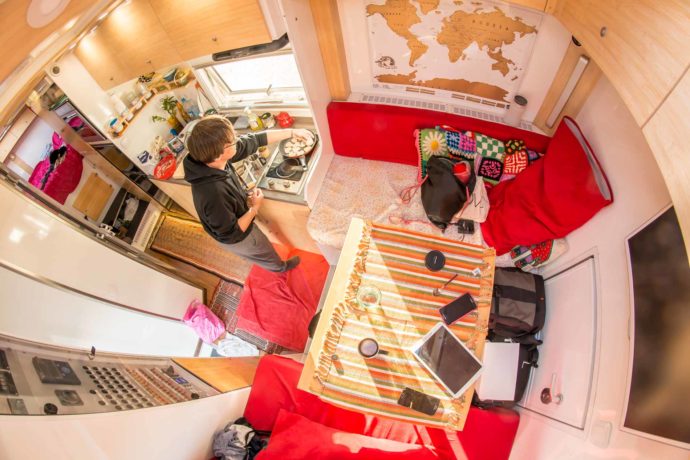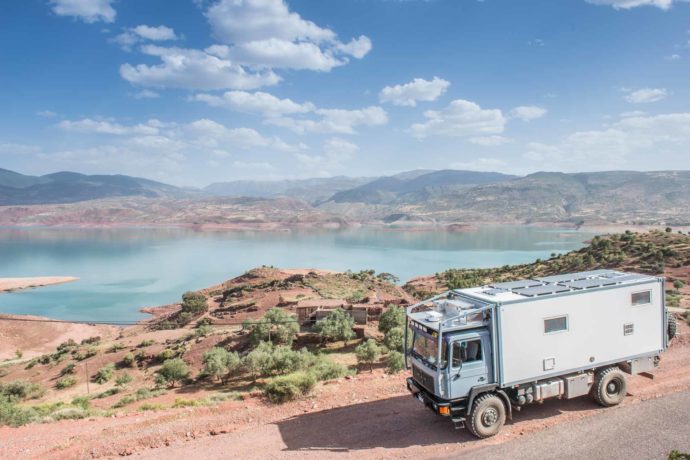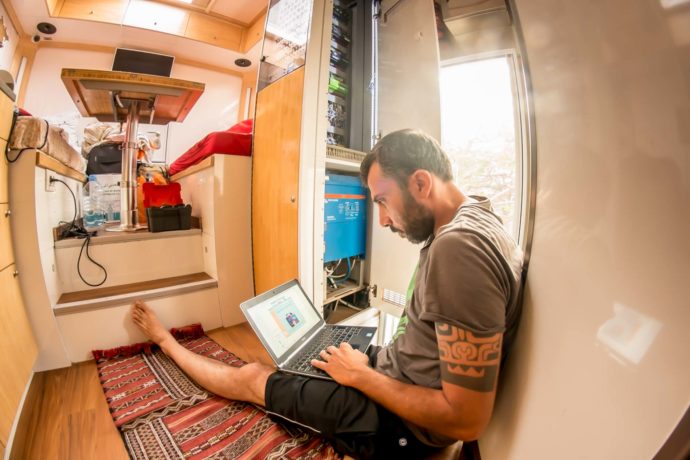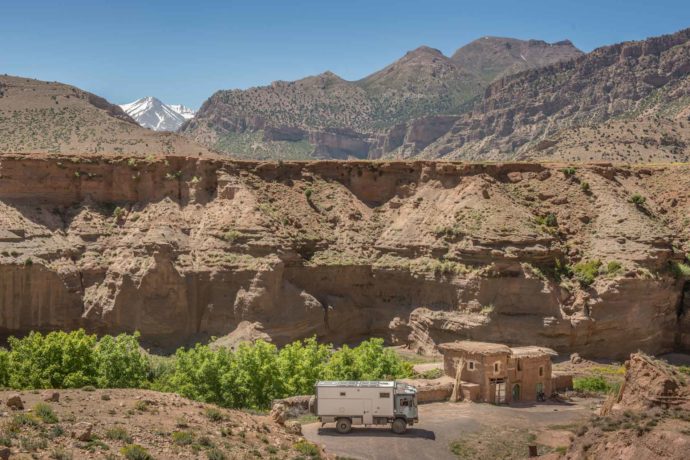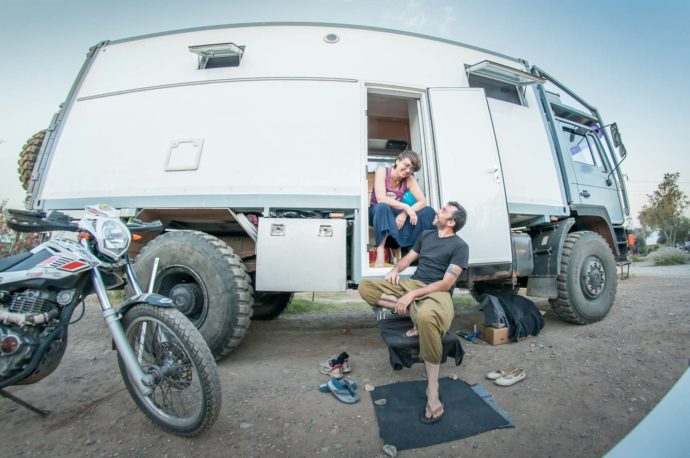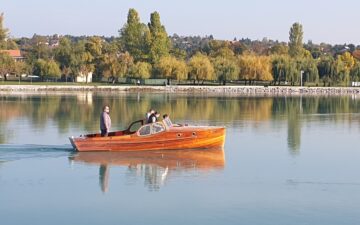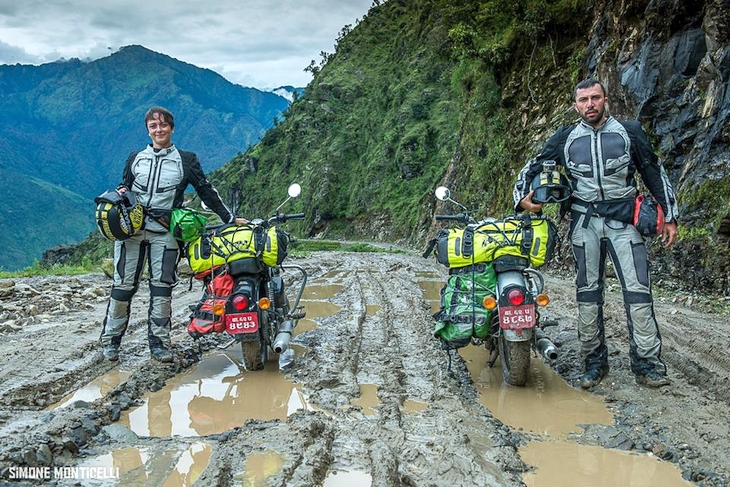
Introduction
I stumbled across Simone Monticelli (Simo) and Lucia Gambelli (Lucy) on Facebook and was delighted to discover they are fellow motorcyclists and adventurers. Having said that when it comes to adventures they leave me eating their dust and mud with their wide ranging global travels. Looking at their photos from Royal Enfield motorcycles in the Nepalese mud to Unimogs in the Saharan dust, it was with glee I noticed that telltale Victron blue in one of their photos. I needed to know more and specifically why they chose Victron Energy products for their latest expedition transport.
Being motorcyclists there is only one name, especially when you are from Italy, that you could possibly call your new expedition truck – Valentino after the GOAT – but I’m a different generation so I may dispute that Valentino Rossi is the Greatest Of All Time, it’s Mike Hailwood surely! Borders and nationalities aside, Valentino the Victron equipped expedition Unimog is I suspect a goat in her own right.
Having now swapped their motorcycles for four wheels, here in Simo’s own words is a guest blog with some fantastic photos as Valentino, Simo and Lucy travel – now aboard a boat to South America having recently departed Dakar.
Off the beaten track
The civilisation of a place is often measured by comparing the length of the existing paved roads: do we really want to be so limited?
If we want to discover the DNA of a place we don’t have to stop where the road ends, we have to go further. Where the tarmac ends there are landscapes and people who survive quite differently to the artificial and forced contamination of the usual cliché we call civilisation. It is here that it is possible to meet with a different point of view of the same country. But mind you, not necessarily better, truer or more beautiful, simply different.
If you leave the paved roads you can certainly get into trouble and put yourselves in complicated situations, but we think that is part of the game and these moments can offer learning and a pure contact with populations who seemingly live a harder life with apparently less. We think that the understanding of these contradictions is an important element of any journey.
The right tool for the job
Understanding places off the beaten track means understanding the difficulties of the people who live there and whilst it might seem trivial to most – one such challenge is travel on dirt ‘roads’ without asphalt which is often not feasible by any ordinary means of transport. When travelling in such challenging conditions we need to use a means of transportation purpose built for survival in all situations.
Sand, mud and rocks are just some of difficulties to deal with when the traveller leaves the tarmac. Often you have to travel alone for several days before getting to your desired destination – imagine then what it means if having a technical issue that can ruin your journey in such places? You can’t expect technical assistance in a place without people, or even if someone does pass by that doesn’t mean they can even help! Therefore safety, independence and autonomy becomes really important. That’s why we built Valentino.
Life before and now with Valentino
We are couple of Italians travellers that built our expedition vehicle Valentino from scratch in order to start a new life on the road. We quit our respective jobs for the road, to discover unknown parts of the world. Back in my home country of Italy I was an Internet Security Expert for a top Cyber Security Command Centre. Because of that and knowing about electronics and innovation that has helped us build a truck with a specialised and self sufficient fit-out. During the evaluation phase we had no doubt about the choice of equipment: to have the correct and stable amount of power for all our equipment the choice had to be Victron Energy.
Normally speaking with expedition vehicle owners and long term travellers it is common to hear: “what’s not there, does not break!” During a world trip the fewer malfunctions the better, especially if the travel takes place where the repairs are difficult or nigh on impossible. And yes, that’s right, personally I think that technical innovation can help the reliability of our truck and can also be useful to prevent malfunctions that could damage or significantly compromise the vehicle or indeed our budget. So we decided to take the chance to start our new life on the road with something different to a 40 year old truck to ensure and preserve our new house on wheels for many years. Here’s a blog about the build (in Italian but works well with Chrome browser and inline translation tool into English).
Victron inside
How can we manage our self-sufficiency?
Starting from the power plant, we have installed eight Victron Energy Gel Batteries for a total of 880Ah of power at 24 Volt. With one 5kVA Quattro and two BlueSolar MPPT 150 series this gives Valentino 1.5Kw of solar power.
With this we can use our induction stove, a microwave, a fridge, a television with automatic satellite antenna and give the power to many other things such as an internet router, video surveillance system, a 32TB NAS, etc, etc.
To ensure even more reliability to the entire installation we have also installed other Victron components such as a Battery Balancer, a BatteryProtect plus a lot of marine grade circuit breakers. To control the entire Victron installation we opted for the Color Control GX which is normally attached to the Internet through a router. As I alluded to before we were looking forward to system innovation, so for that reason we put in communication with all the Victron equipment to provide a home automation system. Why? For several years we had heard about home automation installed in conventional homes, so when we started Valentino’s build we thought why not use such a system to take care of and monitor our new mobile house.
Automation is very useful for controlling all the equipment from the console panel and also for checking any event which may prejudice reliability of the installation, for example: flooding, excessive energy consumption, rising temperatures, etc, etc. We have installed many temperature sensors that, thanks to the home automation program can actuate the vents for extraction of heat in 5 different compartments, such as the Batteries, the Quattro, the MPPTs, etc. There are also some humidity sensors that actuate vents in the shower, sensors for flooding with an alarm system and automatic block of pumps to stop water ingress.
Whilst we know that the perfect vehicle doesn’t exist, our life on the road requires capacity for adaptation because sooner or later there will be some challenges to deal with – but we hope we have anticipated scenarios at the design and build stage in order to solve problems before they can happen and cause any damage. In doing so we feel Victron Energy products have made a significant contribution toward this aim. Time will tell and hopefully in future we’ll get a chance to let you know how our travels in Valentino are going.
Simone Monticelli
Conclusion
It’s clear that English is not Simone’s native language yet I’ve edited very little of his words as it is perfect the way it is – so you the reader can feel that Italian passion for adventure and technical innovation.
In sending me the information for this blog Simone only asks for one thing as they travel, support from Victron’s worldwide personnel should it be needed, and indeed contact with any other Victron equipped globetrotters. That doesn’t seem too much to ask, especially as they have quite purposefully bought and chosen Victron products with that global support in mind.
I’d like to thank Simone and Lucia for the words and wonderful photos. Hopefully we’ll catch up with their travels and lessons learned once they arrive and travel some more on the other side of the Atlantic.
For now then – Bon Voyage Simo & Lucy!
Links
Website – http://www.stepsover.com
Facebook – https://www.facebook.com/stepsoverASD
YouTube – https://www.youtube.com/user/smontic
Twitter – https://twitter.com/stepsover



